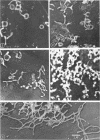Abstract
Kim, Kwang S. (University of North Carolina, Chapel Hill), Wallace A. Clyde, Jr., and Floyd W. Denny. Physical properties of human mycoplasma species. J. Bacteriol. 92:214–219. 1966.—Studies were made of the comparative morphology and stability of five Mycoplasma species of human origin (M. hominis type 1, M. salivarium, M. fermentans, M. pneumoniae, M. pharyngis). Broth-cultivated organisms were examined by electron microscopy to determine their relative appearance after uniform processing, including fixation-drying with formaldehyde vapor. M. pneumoniae was characterized by the occurrence of 250- to 300-mμ spheres in clusters, and M. pharyngis by the appearance of filaments 120 mμ by 1.5 to 8 μ; the remaining species revealed a variety of structures, including spheres, rings, and short filaments. To complement these findings, the effect of physical stresses on viability of the mycoplasmas was measured by exposing the organisms to heat (in saline), osmotic variations (in sucrose), and sonic oscillation and repetitive freeze-thawing (in culture medium). M. pneumoniae was most resistant to heat, vibration, and freeze-thawing; M. pharyngis was most sensitive to heart and vibration, but was least affected by osmotic changes. The remaining organisms assumed intermediate positions. The type-related variations in relative morphology and stability suggest differing physical attributes of the mycoplasmas studied, supporting taxonomic differentiation of the five species based on metabolic and immunological criteria.
Full text
PDF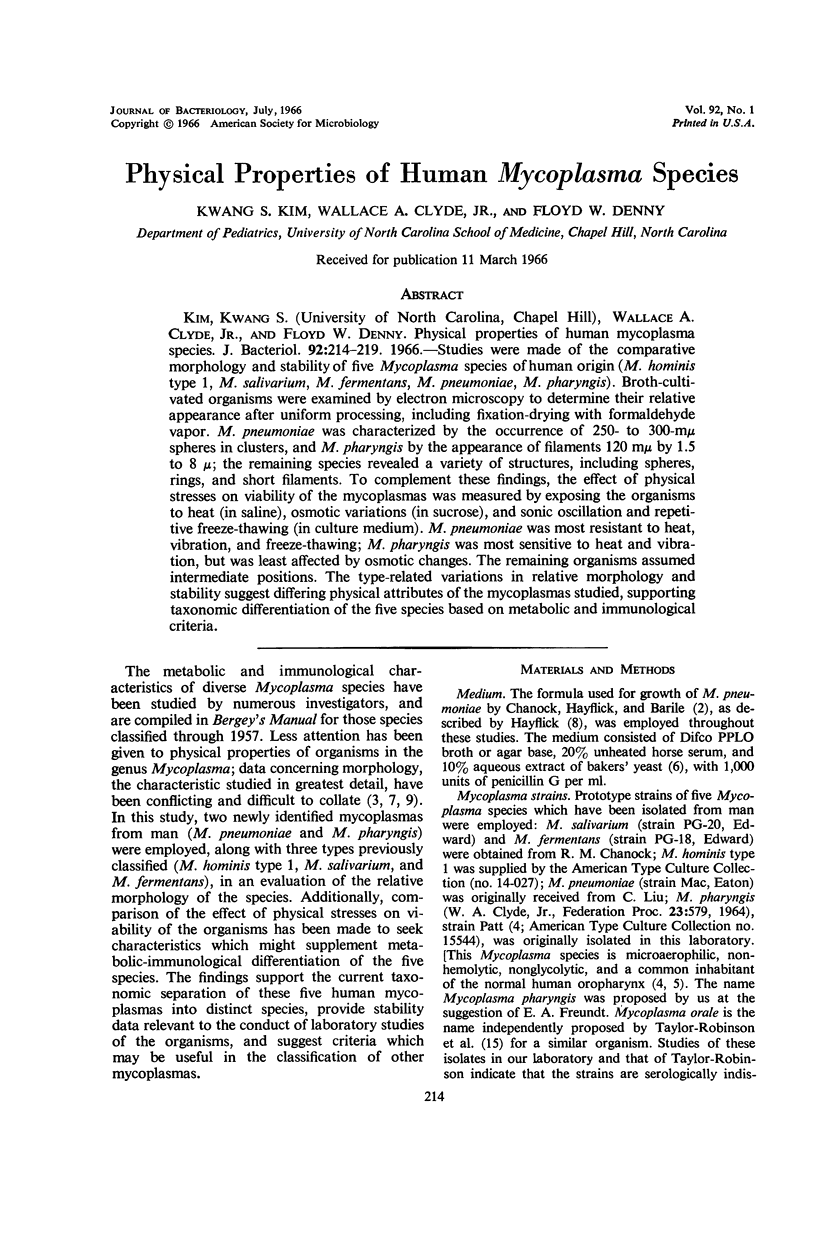
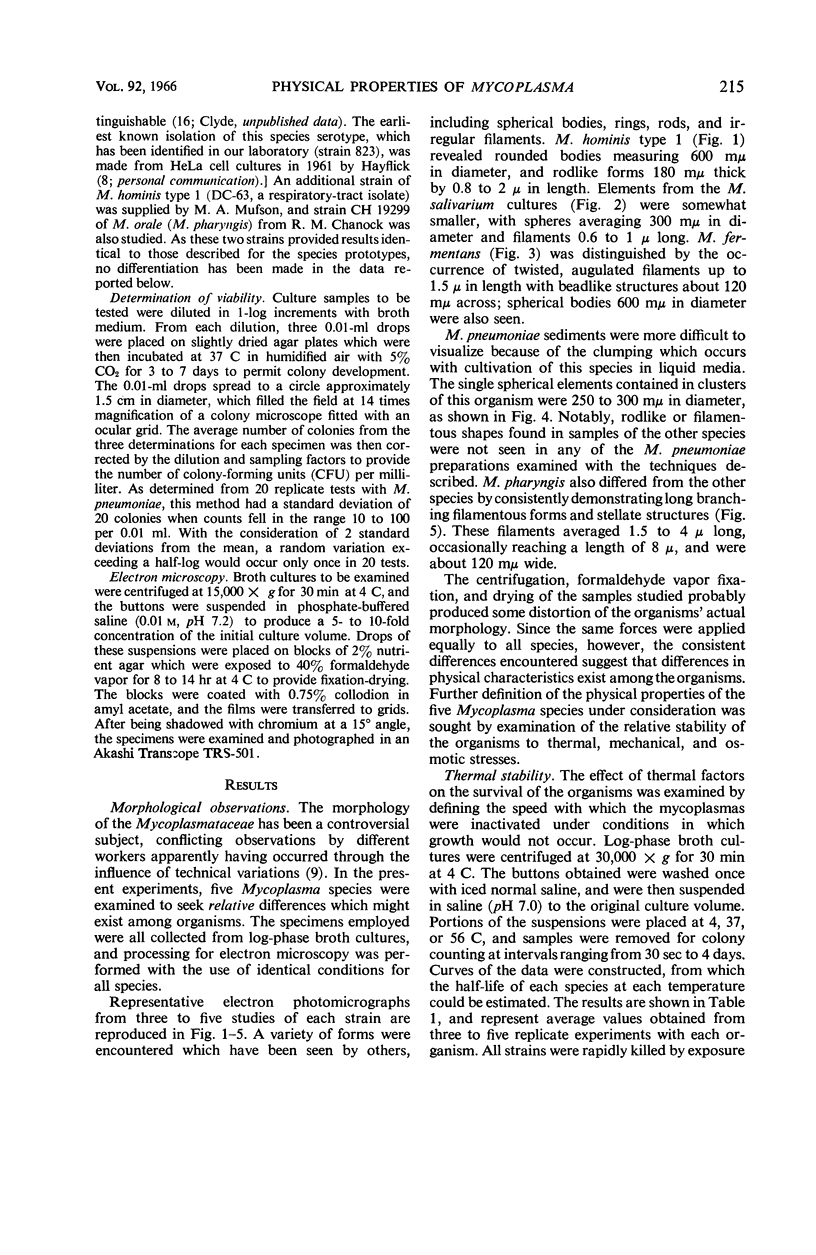
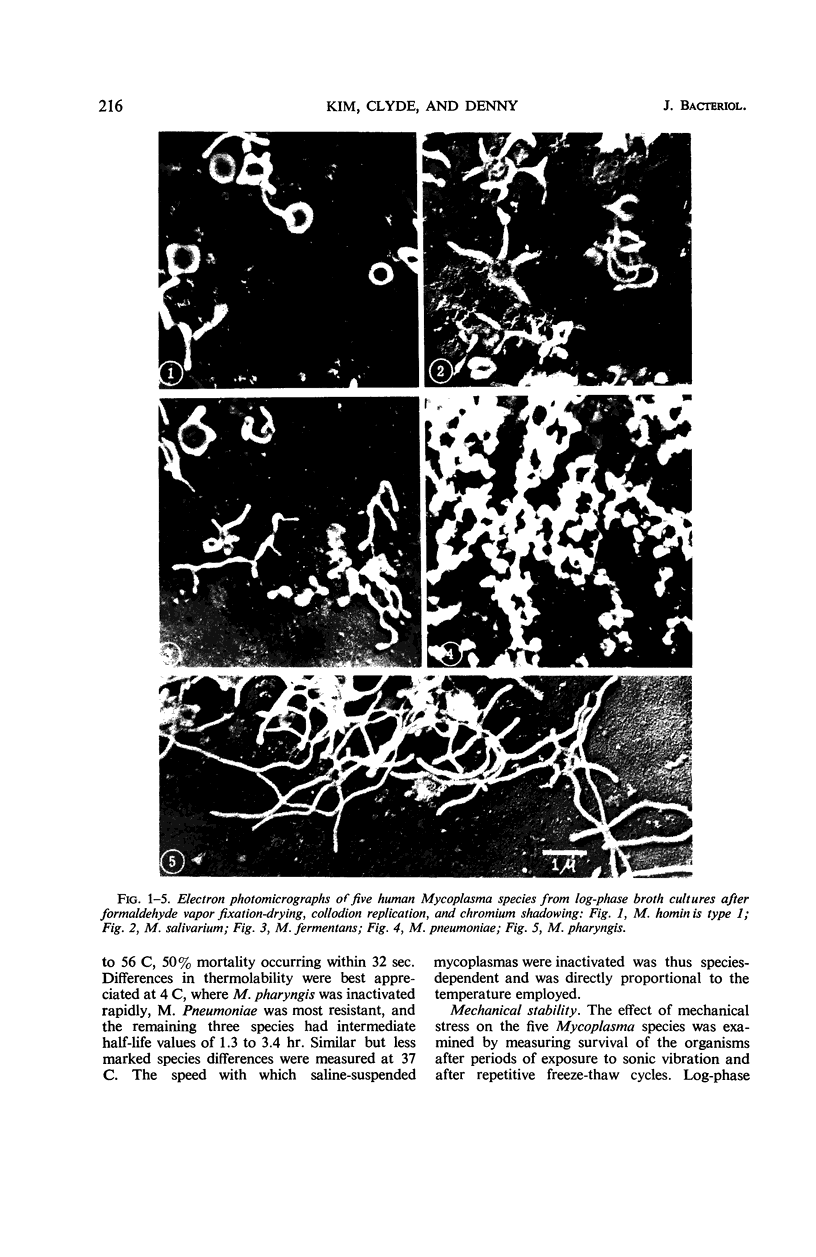

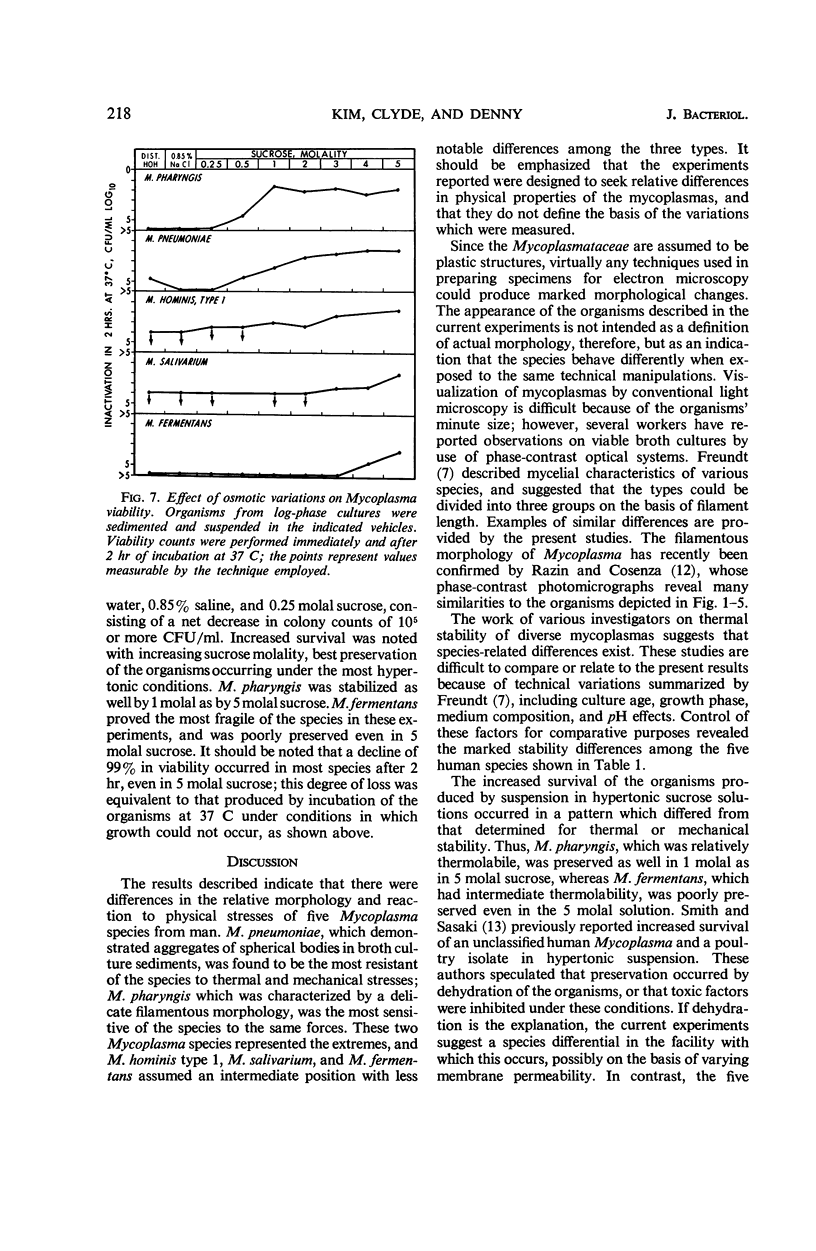
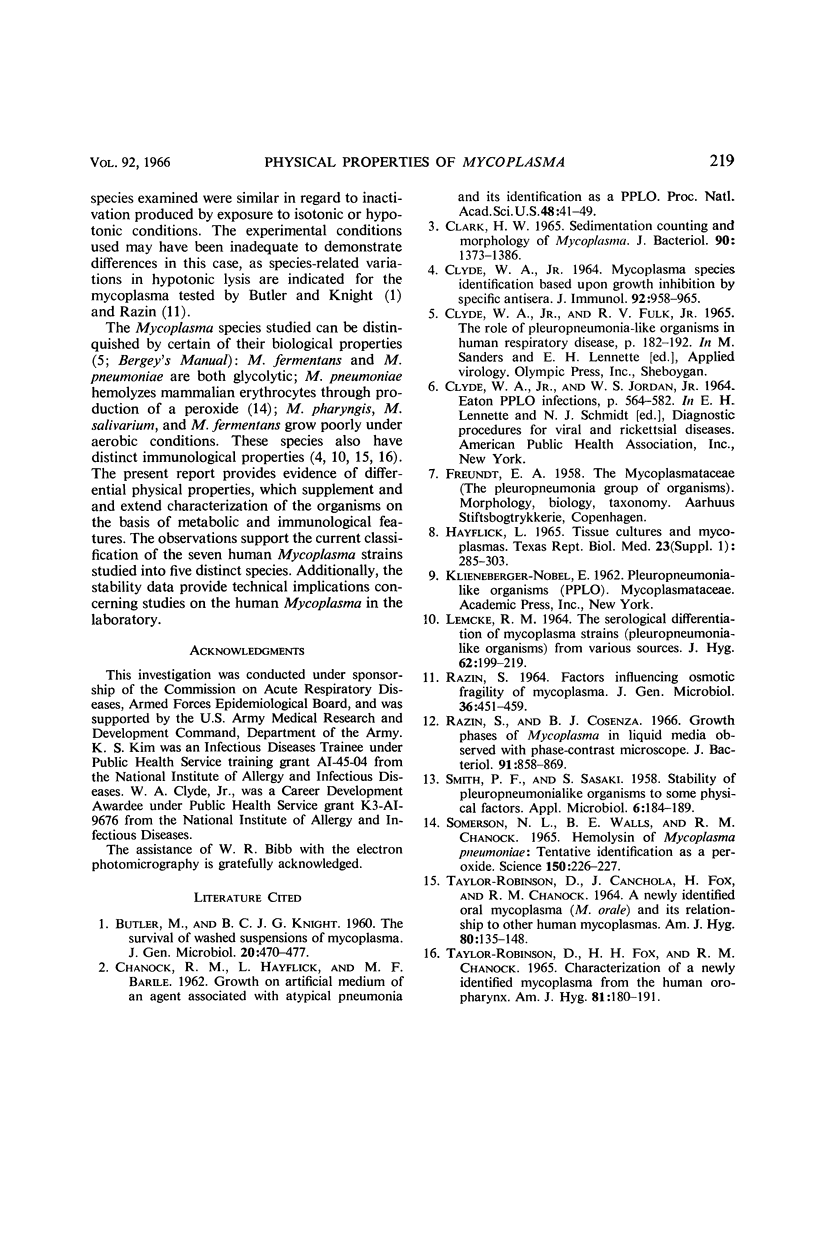
Images in this article
Selected References
These references are in PubMed. This may not be the complete list of references from this article.
- BUTLER M., KNIGHT B. C. The survival of washed suspensions of Mycoplasma. J Gen Microbiol. 1960 Apr;22:470–477. doi: 10.1099/00221287-22-2-470. [DOI] [PubMed] [Google Scholar]
- CHANOCK R. M., HAYFLICK L., BARILE M. F. Growth on artificial medium of an agent associated with atypical pneumonia and its identification as a PPLO. Proc Natl Acad Sci U S A. 1962 Jan 15;48:41–49. doi: 10.1073/pnas.48.1.41. [DOI] [PMC free article] [PubMed] [Google Scholar]
- CLYDE W. A., Jr MYCOPLASMA SPECIES IDENTIFICATION BASED UPON GROWTH INHIBITION BY SPECIFIC ANTISERA. J Immunol. 1964 Jun;92:958–965. [PubMed] [Google Scholar]
- Clark H. W. Sedimentation counting and morphology of Mycoplasma. J Bacteriol. 1965 Nov;90(5):1373–1386. doi: 10.1128/jb.90.5.1373-1386.1965. [DOI] [PMC free article] [PubMed] [Google Scholar]
- Hayflick L. Tissue cultures and mycoplasmas. Tex Rep Biol Med. 1965 Jun;23(Suppl):285+–285+. [PubMed] [Google Scholar]
- LEMCKE R. M. THE SEROLOGICAL DIFFERENTIATION OF MYCOPLASMA STRAINS (PLEURO-PNEUMONIA-LIKE ORGANISMS) FROM VARIOUS SOURCES. J Hyg (Lond) 1964 Jun;62:199–219. doi: 10.1017/s0022172400039930. [DOI] [PMC free article] [PubMed] [Google Scholar]
- RAZIN S. FACTORS INFLUENCING OSMOTIC FRAGILITY OF MYCOPLASMA. J Gen Microbiol. 1964 Sep;36:451–459. doi: 10.1099/00221287-36-3-451. [DOI] [PubMed] [Google Scholar]
- Razin S., Cosenza B. J. Growth phases of Mycoplasma in liquid media observed with phase-contrast microscope. J Bacteriol. 1966 Feb;91(2):858–869. doi: 10.1128/jb.91.2.858-869.1966. [DOI] [PMC free article] [PubMed] [Google Scholar]
- SMITH P. F., SASAKI S. Stability of pleuropneumonialike organisms to some physical factors. Appl Microbiol. 1958 May;6(3):184–189. doi: 10.1128/am.6.3.184-189.1958. [DOI] [PMC free article] [PubMed] [Google Scholar]
- Somerson N. L., Walls B. E., Chanock R. M. Hemolysin of Mycoplasma pneumoniae: tentative identification as a peroxide. Science. 1965 Oct 8;150(3693):226–228. doi: 10.1126/science.150.3693.226. [DOI] [PubMed] [Google Scholar]
- TAYLOR-ROBINSON D., CANCHOLA J., FOX H., CHANOCK R. M. A NEWLY IDENTIFIED ORAL MYCOPLASMA (M. ORALE) AND ITS RELATIONSHIP TO OTHER HUMAN MYCOPLASMAS. Am J Hyg. 1964 Jul;80:135–148. doi: 10.1093/oxfordjournals.aje.a120454. [DOI] [PubMed] [Google Scholar]
- TAYLOR-ROBINSON D., CHANOCK R. M. CHARACTERIZATION OF A NEWLY IDENTIFIED MYCOPLASMA FROM THE HUMAN OROPHARYNX. Am J Epidemiol. 1965 Mar;81:180–191. doi: 10.1093/oxfordjournals.aje.a120506. [DOI] [PubMed] [Google Scholar]



